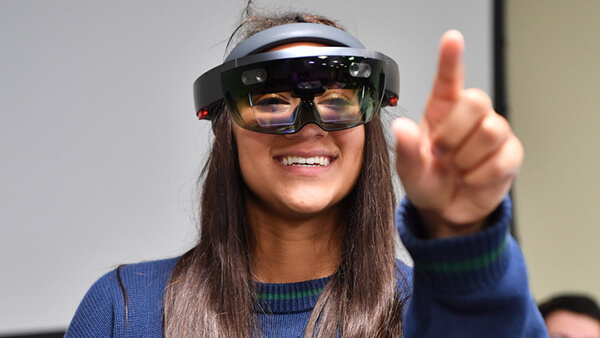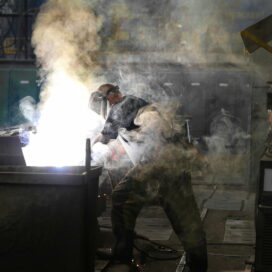A HoloLens view of mixed reality
Published: November 30, 2017 / Author: Christine Cox

To understand mixed reality, as opposed to other forms of reality, it is helpful to envision a dog sitting in a room.
In the real world, you see an actual dog sitting in an actual room. Both exist physically.
In virtual reality, you see a digital dog sitting in a digital room. Both exist in an artificial world that is not integrated with the actual world.
In mixed reality, you see a holographic, three-dimensional dog sitting in an actual room — a merging of a digital object with a physical location. And not only can you see the dog, you can walk around it, view it from all sides, see it wag its tail and hear it bark.
MIXED REALITY THROUGH MICROSOFT HOLOLENS
This merging of two worlds can be startlingly real, as students discovered while sliding on Microsoft HoloLens headsets in class this fall. Suddenly, a virtual dog appeared, wagging its tail and panting. Its presence felt real enough to make some students gasp.
The dog was the simplest example of mixed reality that undergraduate students in Wendy Angst’s Business Problem Solving class experienced that day. Under the guidance of guest speaker Matt Joe, an expert in immersive technology and artificial intelligence (AI), they examined and rearranged products on a virtual grocery store shelf, moving laundry detergent, fabric softener, floor cleaner and dishwashing detergent to find the best layout to maximize sales.
“We are entering an AI-first world,” said Joe, global innovation officer for Avanade, a joint venture consultancy between Microsoft Corporation and Accenture. “You are all going to fully embrace artificial intelligence in your lifetime. At Avanade, we tell our clients that they need to experiment with AI now, or they’re going to be lost in the future.”
Teams of six worked on projects for a week before presenting their ideas to Joe and Michelle Mercado, a sales director for Avanade.HOLOLENS BUSINESS CHALLENGE
The juniors and seniors in the three sections of Angst’s class tried their hand at a mixed reality consulting project when Joe challenged them to define consulting services based on mixed reality solutions using HoloLens. Beyond moving items from a mixed reality grocery store shelf, how could a corporation use mixed reality to benefit its workforce, products and/or services to its customers?
Among the concepts: A virtual dressing room that would allow HoloLens users to see virtual representations of their bodies to try on clothes from a department store, thus eliminating the need to travel to an actual retailer; a holographic tour guide that would adjust information to the personal interests of a client, which even allow a group of people looking at the same museum exhibit to zero in on elements that interested them; a municipal application that would assist first responders by allowing them to see interactive blueprints of buildings to determine the best response to an emergency.
Senior Anthony Caputo, an IT management major, was part of a group whose idea was judged the best by Joe and Mercado. The team’s concept would allow real estate companies to create virtual renderings of potential buyers’ furniture so that they would be able to stand in a house or commercial property and see how the pieces would fit.
“It was excellent to be able to work with such an innovative technology that hasn’t really hit the markets and then establish a practical use case,” Caputo said. “Our team did a lot of research to see what the HoloLens was already being used for so that we didn’t replicate anything. We really tried to think outside the box as to where we could apply it in different industries.
“We finally landed on real estate and a solution that would allow the industry to lower the price of staging while allowing clients to see their furniture in a house. It was valuable to think through every stage of the process of incorporating mixed reality.”
“The Business Problem Solving course challenges students to solve complex business problems in a compressed time frame using tools and frameworks used by leading consulting firms,” she said. “Emerging technologies provide countless challenges and opportunities for businesses, shaping the way businesses engage with their customers to deliver products and services. DIVING INTO DISRUPTION
Angst, an associate teaching professor of Management & Operations who specializes in innovation, said it’s critical for Mendoza students to understand emerging technologies and their role in business.
“HoloLens has the potential to disrupt a variety of industries in ways yet to be imagined,” she added.
“The mixed reality projects gave students firsthand exposure to solving problems for a future that is still being formed, much the way many corporations of our time have dealt with the advent of social media or Bitcoin, for example. I was impressed by how the students formed creative solutions so quickly and effectively across myriad industries to benefit from the HoloLens.”
For more information about Avanade’s AI-first world, visit avanade.com/techvision.
Related Stories




